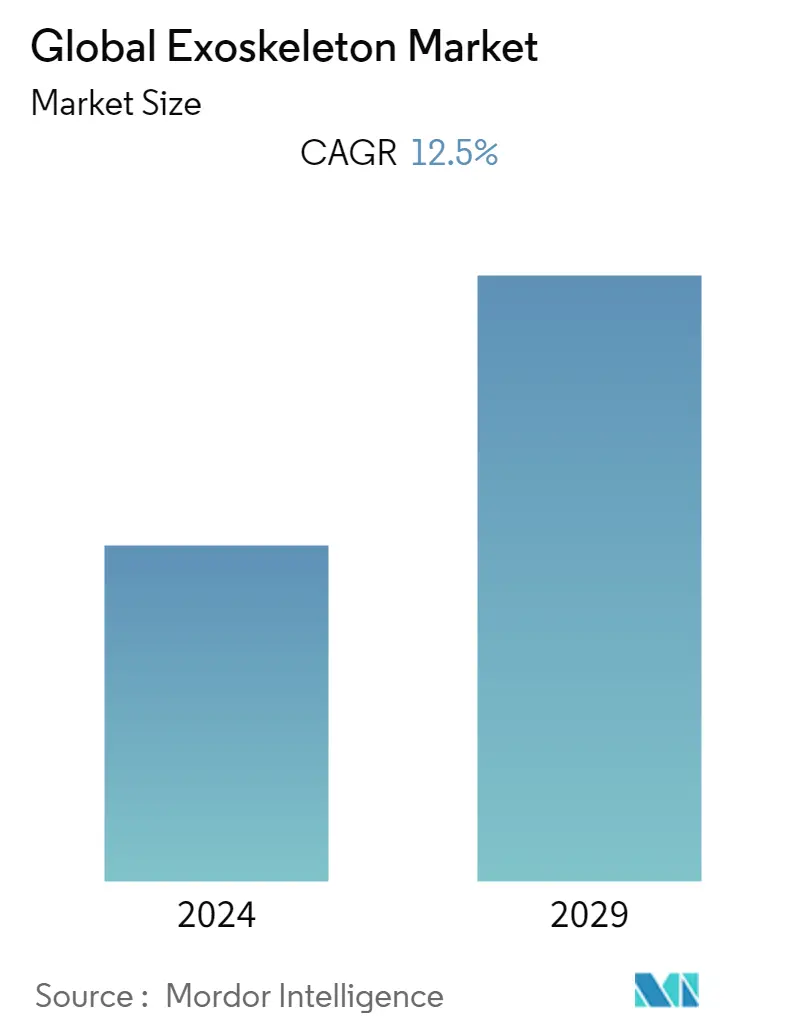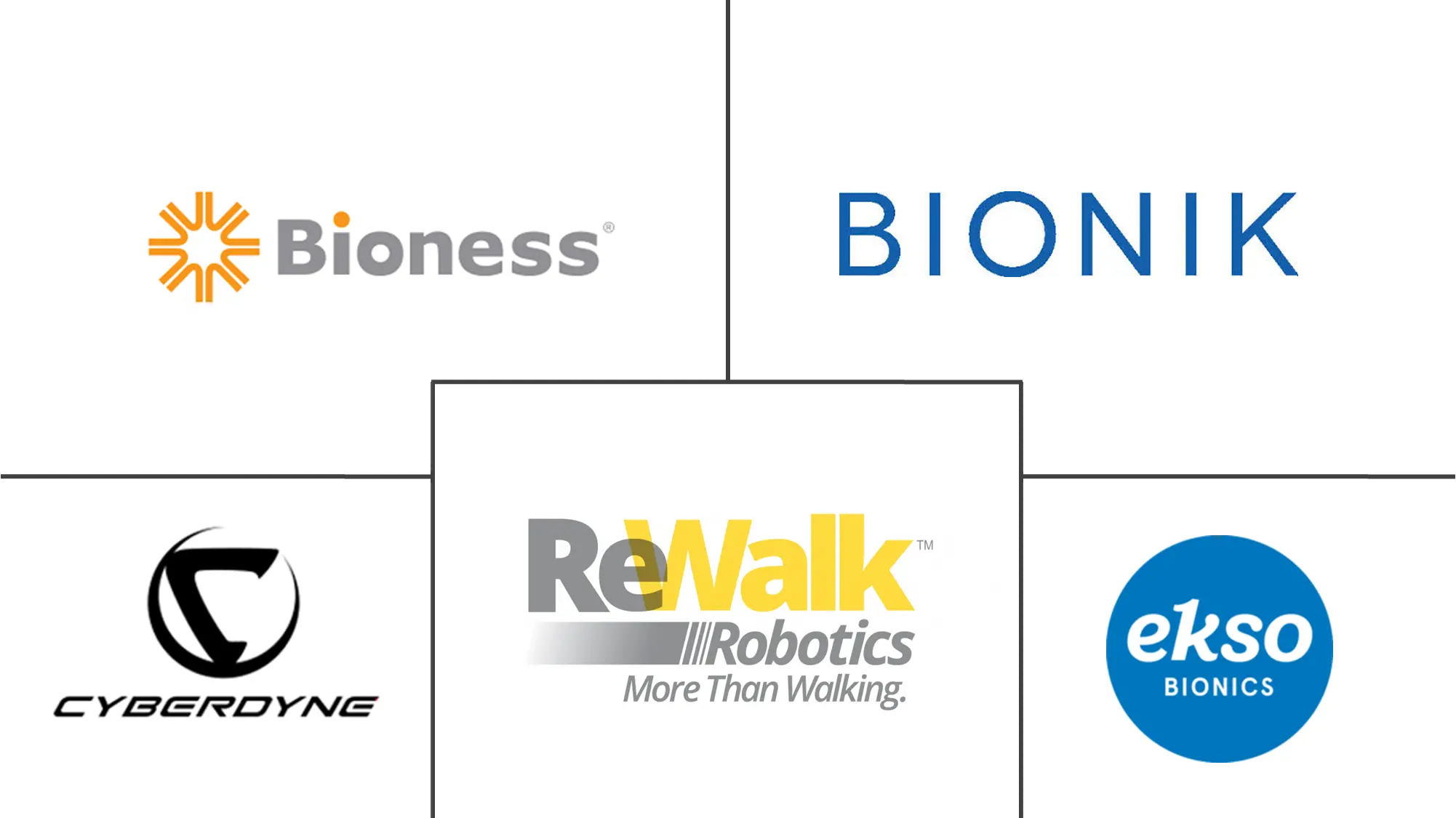Market Size of Global Exoskeleton Industry

| Study Period | 2019 - 2029 |
| Base Year For Estimation | 2023 |
| CAGR | 12.50 % |
| Fastest Growing Market | Asia Pacific |
| Largest Market | North America |
| Market Concentration | Medium |
Major Players
*Disclaimer: Major Players sorted in no particular order |
Exoskeleton Market Analysis
The exoskeleton market was valued at USD 354.22 million in 2021, and it is expected to reach USD 1620.04 million in 2027, registering a CAGR of 12.5% during the forecast period (2022-2027).
The COVID-19 pandemic is an unprecedented health concern, causing a huge setback. The pandemic significantly impacted the exoskeleton market worldwide. The use of exoskeletons is increasing in the management of COVID-19 patients with prolonged disability and problems in movement. For instance, as per a research article published in 2020, titled 'The use of exoskeletons to help with prone positioning in the intensive care unit during COVID-19', the preliminary results confirmed that the use of an exoskeleton for lumbar support is fully justified. The study states that using an exoskeleton to assist medical staff could be helpful and readily feasible, even in the context of the COVID-19 pandemic. As per a research article published in 2021, titled 'Biomechanical effects of using a passive back support exoskeleton during prone-positioning maneuver: A pilot study', during the COVID-19 pandemic, intensive care unit (ICU) staff had to perform prone-positioning (PP) of a large number of intubated patients suffering from acute respiratory distress syndrome (ARDS) many times a day. The study revealed that using the Laevo could help reduce the musculoskeletal load on the lower back during prone positioning maneuvers without causing any significant negative side effects or modifying the practice. The study states that two Laevos were successfully deployed in intensive care units of Centre Hospitalier Régional Universitaire de Nancy (CHRU Nancy), and they were used for six months. Thus, the demand for exoskeletons was significant during the pandemic. With the removal of lockdowns and the development of vaccines, the demand for exoskeletons as a part of rehabilitation is expected to increase. However, as per Ekso Bionics' 2020 annual report, the demand for exoskeleton products dramatically decreased by 38.0% during the onset of the pandemic, leading to the booking of 61 units in 2020 compared to 98 units in 2019.
The major factors propelling the market's growth are the rising prevalence of stroke, increasing adoption of the exoskeleton, and the growing geriatric population at a global level. With the increasing number of disabled and aged people, there has been an increase in the demand for robotic rehabilitation worldwide. In recent years, the demand for physical therapy services has grown, partly because of the aging population. The role of technology in healthcare has become evident with the enhanced rate of survival from medical disorders, such as stroke. Therefore, robotic rehabilitation and assistive technologies promise to ease the stress on the physiotherapy staff and control expenses while refining patients' quality of life.
There has been a growing demand for these robotic rehabilitation devices that are showing an upward trajectory as the prevalence of disability worldwide is increasing. For example, the United Nations estimates that the global geriatric population will reach 2.1 billion by 2050. The rates of disability are increasing due to the aging population and an increase in chronic health conditions. Therefore, the applications of robotic rehabilitation are growing fast with the market for these systems. One example is a robot developed at McGill University that helps patients who use wheelchairs to walk. It supports gait training and neuro-rehabilitation. Other researchers and companies are also developing products using robotics and 3D printing to help patients with movement disorders from an impaired spinal cord or due to stroke, Parkinson's disease, and multiple sclerosis. Numerous hospitals started using robotics within their rehabilitation centers. Product launches and innovations through key market players are another reason for the market's growth. For instance, in February 2020, Ekso Bionics announced a collaboration with Kindred Healthcare to pilot EksoNR in long-term acute care hospitals. Similarly, in January 2020, Bionik laboratories announced the regulatory approval and the first sale of its InMotion arm robotic technology by its exclusive distributor in South Korea. Hence, all these factors are expected to drive the overall market.
Exoskeleton Industry Segmentation
As per the scope of the report, exoskeletons are the external skeleton that supports and protects the body in contrast to the internal skeleton (endoskeleton). These are also wearable machines that enable limb movement with amplified strength and enhance the performance of human tasks. The exoskeleton helps people by providing support in walking, standing, carrying heavy objects, and contributing to healthcare. Using the exoskeleton technology helps reduce the effects of some of the disabilities like paralysis, general fatigue, and muscular dystrophy.
The exoskeleton market is segmented by treatment type (rehabilitation and augmentation), body part type (upper body and lower body), product type (stationary and mobile), and geography (North America, Europe, Asia-Pacific, Middle-East and Africa, and South America). The market report also covers the estimated market sizes and trends for 17 countries across major regions globally. The report offers the value in USD million for the above segments.
| By Treatment Type | |
| Rehabilitation | |
| Augmentation |
| By Body Part Type | |
| Upper Body | |
| Lower Body |
| By Product Type | |
| Stationary | |
| Mobile |
| By Geography | ||||||||
| ||||||||
| ||||||||
| ||||||||
| ||||||||
|
Global Exoskeleton Market Size Summary
The exoskeleton market is poised for significant growth, driven by the increasing prevalence of disabilities and the aging global population. The demand for robotic rehabilitation devices is on the rise as these technologies offer promising solutions for improving the quality of life for individuals with movement disorders. The market is experiencing a surge in interest due to the growing adoption of exoskeletons in healthcare settings, particularly for stroke rehabilitation and support for geriatric patients. The COVID-19 pandemic highlighted the utility of exoskeletons in medical settings, as they were used to assist healthcare workers and patients with mobility challenges. This has led to a renewed focus on the development and deployment of these technologies in rehabilitation programs worldwide.
North America holds a significant share of the exoskeleton market, supported by high purchasing power, a robust geriatric population, and substantial investments in research and development. Key market players, including Cyberdyne, Ekso Bionics Holdings, Rewalk Robotics, and Bionik Laboratories, are actively investing in innovative product development and seeking regulatory approvals to enhance their market presence. The market's growth is further bolstered by strategic partnerships and collaborations aimed at integrating exoskeleton technology into rehabilitation practices. As the demand for advanced rehabilitation solutions continues to rise, the exoskeleton market is expected to expand, offering new opportunities for both patients and healthcare providers.
Global Exoskeleton Market Size - Table of Contents
-
1. MARKET DYNAMICS
-
1.1 Market Overview
-
1.2 Market Drivers
-
1.2.1 Growing Demand from Healthcare Sector for Robotic Rehabilitation
-
1.2.2 Advancement in Robotic Technologies
-
1.2.3 Huge Investment for the Development of the Exoskeleton Technology
-
-
1.3 Market Restraints
-
1.3.1 Risks Involved with Using Exoskeletons Due to Vague Safety Guidelines
-
-
1.4 Porter's Five Forces Analysis
-
1.4.1 Threat of New Entrants
-
1.4.2 Bargaining Power of Buyers/Consumers
-
1.4.3 Bargaining Power of Suppliers
-
1.4.4 Threat of Substitute Products
-
1.4.5 Intensity of Competitive Rivalry
-
-
-
2. MARKET SEGMENTATION
-
2.1 By Treatment Type
-
2.1.1 Rehabilitation
-
2.1.2 Augmentation
-
-
2.2 By Body Part Type
-
2.2.1 Upper Body
-
2.2.2 Lower Body
-
-
2.3 By Product Type
-
2.3.1 Stationary
-
2.3.2 Mobile
-
-
2.4 By Geography
-
2.4.1 North America
-
2.4.1.1 United States
-
2.4.1.2 Canada
-
2.4.1.3 Mexico
-
-
2.4.2 Europe
-
2.4.2.1 Germany
-
2.4.2.2 United Kingdom
-
2.4.2.3 France
-
2.4.2.4 Italy
-
2.4.2.5 Spain
-
2.4.2.6 Rest of Europe
-
-
2.4.3 Asia-Pacific
-
2.4.3.1 China
-
2.4.3.2 Japan
-
2.4.3.3 India
-
2.4.3.4 Australia
-
2.4.3.5 South Korea
-
2.4.3.6 Rest of Asia-Pacific
-
-
2.4.4 Middle-East and Africa
-
2.4.4.1 GCC
-
2.4.4.2 South Africa
-
2.4.4.3 Rest of Middle-East and Africa
-
-
2.4.5 South America
-
2.4.5.1 Brazil
-
2.4.5.2 Argentina
-
2.4.5.3 Rest of South America
-
-
-
Global Exoskeleton Market Size FAQs
What is the current Global Exoskeleton Market size?
The Global Exoskeleton Market is projected to register a CAGR of 12.5% during the forecast period (2024-2029)
Who are the key players in Global Exoskeleton Market?
Ekso Bionics Holdings, Rewalk Robotics, Cyberdyne, Bionik Laboratories and Bioness Inc. are the major companies operating in the Global Exoskeleton Market.

